|
BULB LOG 50 --- 13th December 2006
I had a wonderful trip down to Kent and Sussex last week where I spoke to five Alpine Garden Society groups, our English cousins. I also visited Wakehurst, Kew and Wisley gardens and you can see a few pictures on the bulb-log-feed-back pages of the Forum. Thanks to all my hosts and the groups for making my trip such a pleasure.
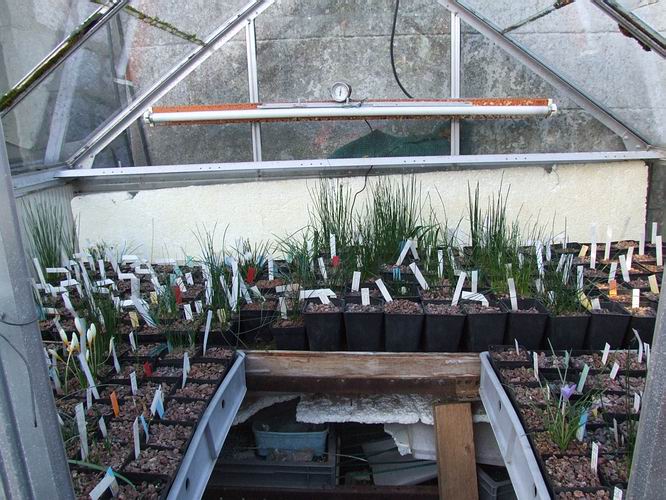
Gothenburg annex
Whenever I return from a trip, no matter how long I have been away, the first thing I like to do is have a tour of the glasshouses to see what is going on. In what I call the Gothenburg annex, which now contains bulbs from many sources, everything looks fine and I can tell from the sand bed and the plants that they have plenty moisture for now. If the sand bed and the gravel top dressing on the pots looked dry then I would have to consider watering the pots with leaves showing. From the questions I am asked at my talks it would seem that a lack of watering and feeding is the most common reason that people fail to get their bulbs to flower and increase. I will try to explain the method and reasoning behind my watering regime as we go through this week's log and in subsequent logs.
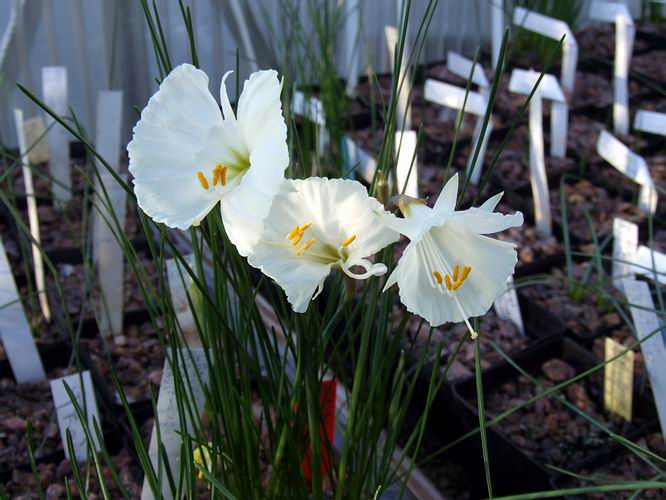
Narcissus seedling split corona
In the Gothenburg annex this Narcissus seedling is in flower and it is showing a strong tendency to have a split corona - I have it marked as a white N. romieuxii seedling. It is one of our own seedlings that sowed itself into the sand plunge and I selected it out because it was white. I have not recorded on the label this splitting of the corona before but this is just the third year of flowering. This splitting of the corona could be due to the season's environment and climate or it could be genetic. I am not keen on spilt coronas and if this is genetic and this plant does repeat this aberration next year then I will dispose of it.
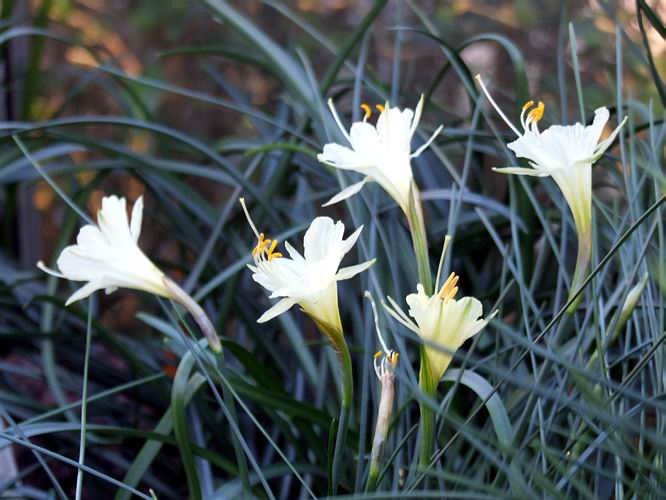
Narcissus hybrid
On the other hand I am very pleased with the progress I am making with this Narcissus hybrid raised by the late Don Stead. I received two hybrids from Don, one I named after him and I would like to name this one for his wife, Joan Stead, who was also a great grower of bulbs and alpines. It is now increasing well and I hope to distribute it in the next few years - both this one and N. 'Don Stead' have been distributed around in Scotland for a good number of years but without names.
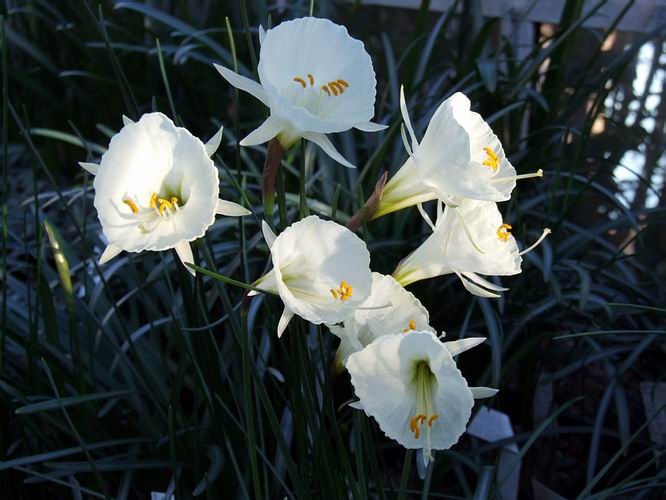
Narcissus 'Camoro' seedlings
Another good hybrid raised in Scotland by Henry Taylor is Narcissus 'Camoro', it is a cantabricus x romieuxii, and it is fertile regularly producing a good seed set. I have raised a number of bulbs from 'Camoro': like this group, most of which are not that dissimilar to the parent.
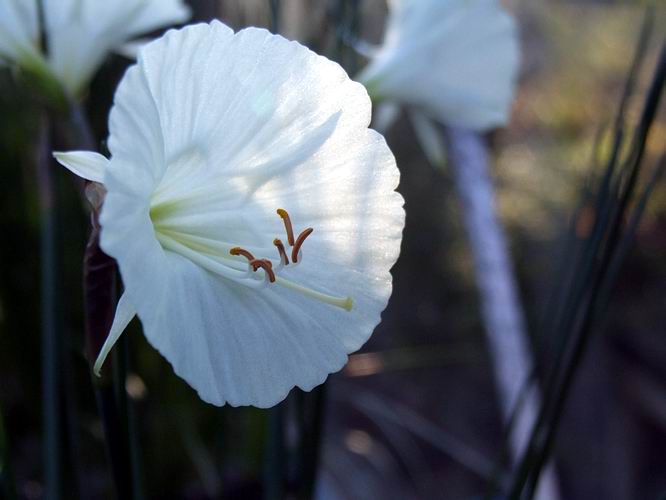
Narcissus seedling
Occasionally there is one that will stand out as being different from the rest, like this one with a very large, flared and much flatter corona. With the large numbers of narcissus we grow so closely, it is possible that a further cross has been made and this flower could be the result of 'Camoro' crossing back to romieuxii which could explain the flower shape. I will separate it out before the flower fades completely and grow it on separately to see how it performs; watch this space.
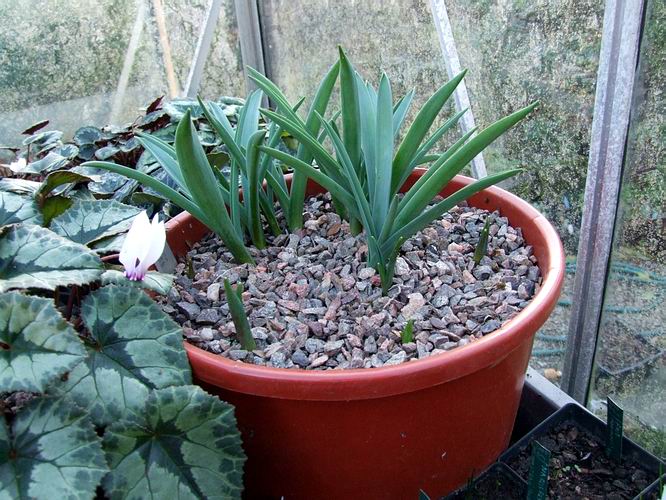
Muscari macrocarpum
This pot of Muscari macrocarpum shows another problem we face when growing bulbs in pots - uneven growth rate. What has caused the bulbs at one side of this pot to grow much faster than the ones on the opposite side? There are a few possibilities we have to consider. The most obvious is that it is the side that is facing south and so has been warmed more by the sun that is most advanced in growth, regular turning of the pot would help to alleviate this. Plunging the pot in sand would also reduce uneven growth as it helps even out the temperature difference around the pot. There are however a few more possible causes of uneven growth that we have to consider - if I had not watered the pot properly and so the moisture was distributed unevenly in the compost, the bulbs on the dry side would be slower into growth. If your pots are not level when you water them this can result in the low side being damper than the high side so it is important to keep your pots as level as you can in the plunge. Yet another fact
or is if the bulbs are seed raised and so are not clonal then they may just be destined to grow at slightly different times. In the case of this pot I can tell you that the difference in growth, from one side to the other, is entirely due to the fact that the pot is not plunged and it has not been turned.
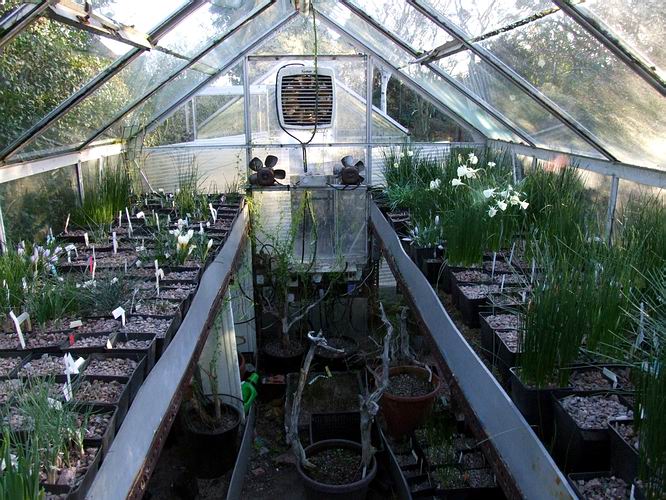
Bulb house
You can see from this picture of the bulb house that many of the narcissus and early crocus have a lot of leaf growth already. It is critical that you give these bulbs plenty of water when their leaves are growing rapidly like this. All this leaf growth takes a lot of water and nutrients and if we do not supply it then the bulb will use up its food stored in the bulb which naturally causes the bulb to shrink in size. If you continue to underwater your bulbs through the rest of the growing season then you will have smaller bulbs than you started out with. The reaction of many bulbs, such as crocus and narcissus, to under watering and hence under feeding is to break down into several small bulbs rather than one flowering sized one. We have to apply plenty of water when the bulbs are in active leaf growth because it is only when they are taking up water that they can take up food - otherwise they use up their reserve of food stored in the bulb.
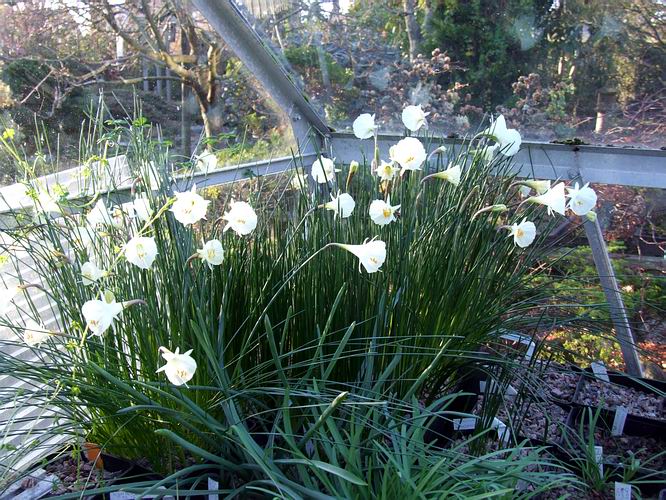
Narcissus 'Camoro'
Look at the extent of the leaf growth on these Narcissus 'Camoro' bulbs, it is rather long and drawn by our poor light, but it all has to be fueled from somewhere. It is too late to apply masses of water to these bulbs now as the rapid growth phase is over. I will give these pots a good soaking on the first bright sunny frost free morning we get and in these colder conditions that should keep them going for several weeks unless the temperature rises again. If you think you have under watered your bulbs you have a chance to restore the situation when the temperatures rise in February and March by giving them regular watering and extra sulphate of potash to help the bulb build up its food reserve, I will cover that when the time arrives.
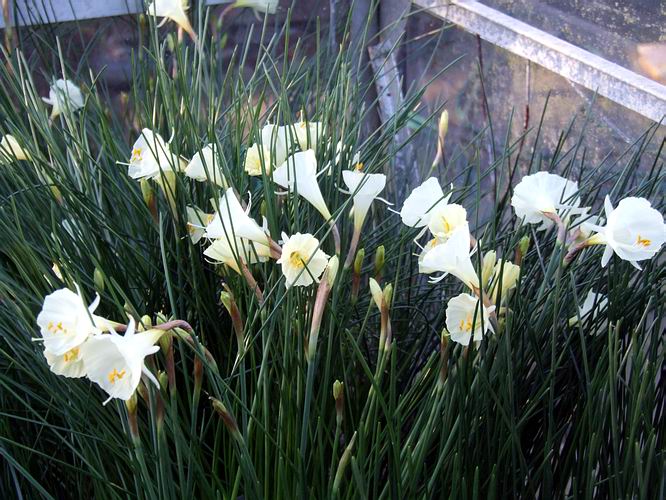
Narcissus romieuxii mesatlanticus
At the other end of this plunge Narcissus romieuxii mesatlanticus is also in full flower. This will receive similar treatment getting watered on good clear frost free mornings; then I allow the pots to nearly dry out before I give them a through soaking again by flooding the pot with water. They are not making any more growth just now, just ticking over in the colder periods, the next stage of growth will come when the flowers fade, which may not be for 6 or 8 weeks, then the seeds and the bulb will start to grow.
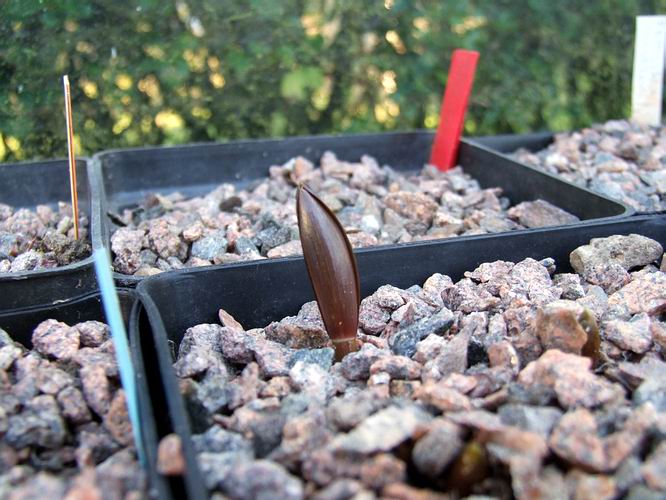
Fritillaria yuminensis bud
In the frit house things are very different as not much has surfaced yet except for a few shoots on Fritillaria yuminensis, one of which is 2-3cms tall. These pots which are showing little or no growth above the surface just need to be kept moist so that the roots already formed below do not dry out completely and get damaged. When the leaves start to grow rapidly early next year that is when they need plenty of water.
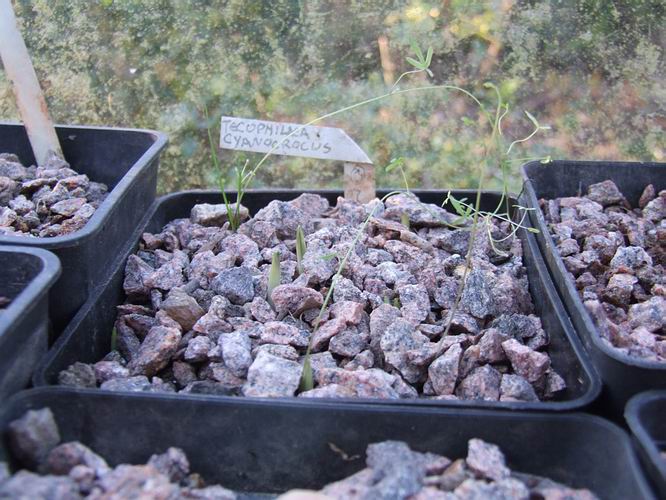
Tecophilaea shoots
Likewise these emerging shots on the Tecophilaeas will not come into flower for us until March or April so I will just keep the compost moist with an occasional watering on a bright frost free day. Notice the small climber seedlings also appearing from this pot; these are Tropaeolum azureum. The seed must have fallen into the pots when they were growing next to each other last year and as I did not get round to repotting the Tecophilaeas the seed was not lost just misplaced.
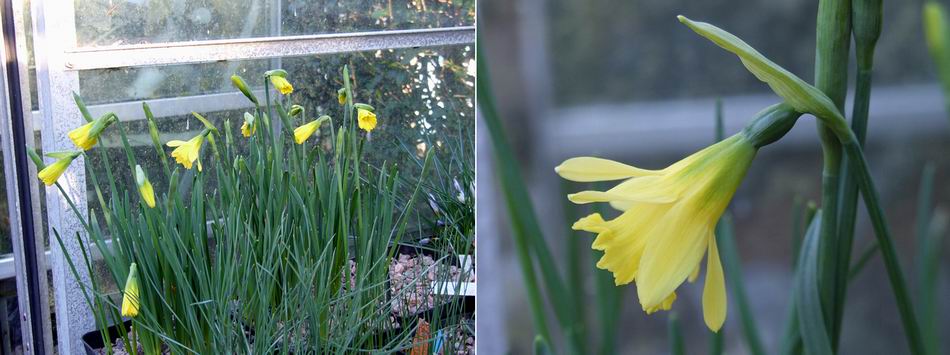
Narcissus 'Cedric Morris'
That old faithful Narcissus 'Cedric Morris', always the first of the trumpet daffodils to flower, is just opening its first flowers. It has also needed a plentiful supply of water to fuel all that new growth. Watering bulbs, especially these winter flowering ones, is never easy because you can get it wrong both ways. Too little water can stunt bulb growth but if you give too much water when the bulb is not using it up in its rapid growth pause then you can get wet rots attacking the bulbs so if your bulbs have well formed leaves already do not be tempted to make up for any lack of watering now, wait until the next growth phase when they will start to build their bulbs - I will tell you when.
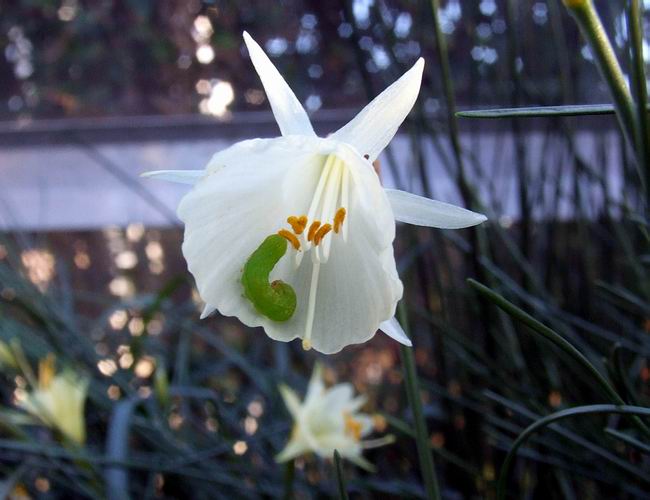
Not a pollinator
The mild early winter conditions bring many surprises but this is not a pollinator - it does not fool me. It is a good reminder to be ever watchful for pests especially aphids, I am still spraying with a systemic insecticide on bright clear days as more new leaves emerge.
^ back to the top ^
|

